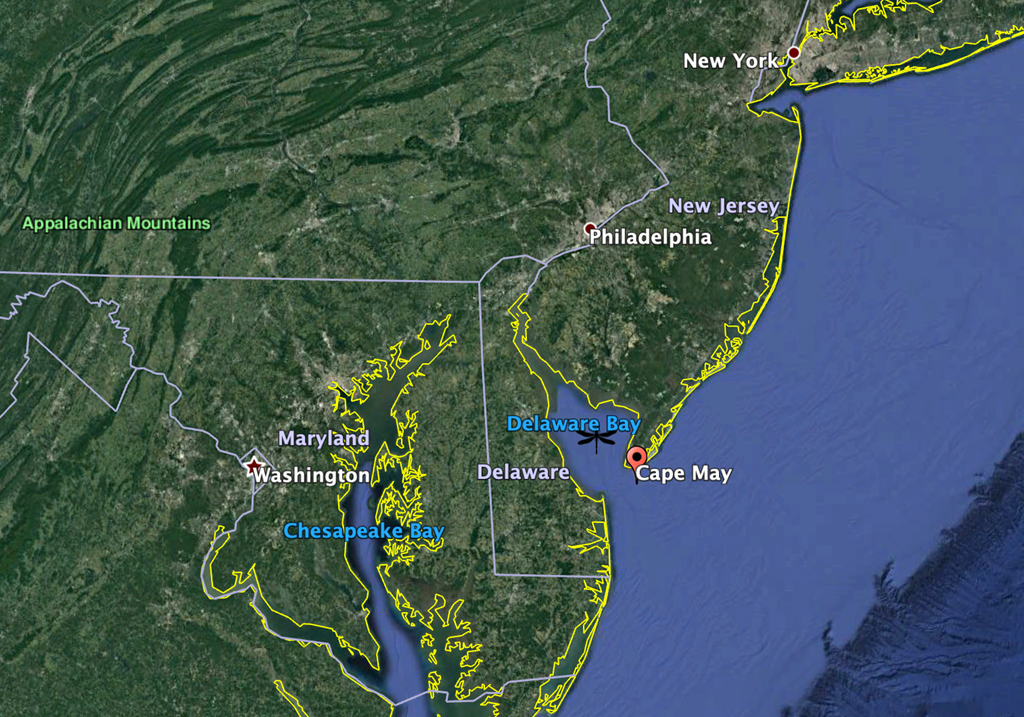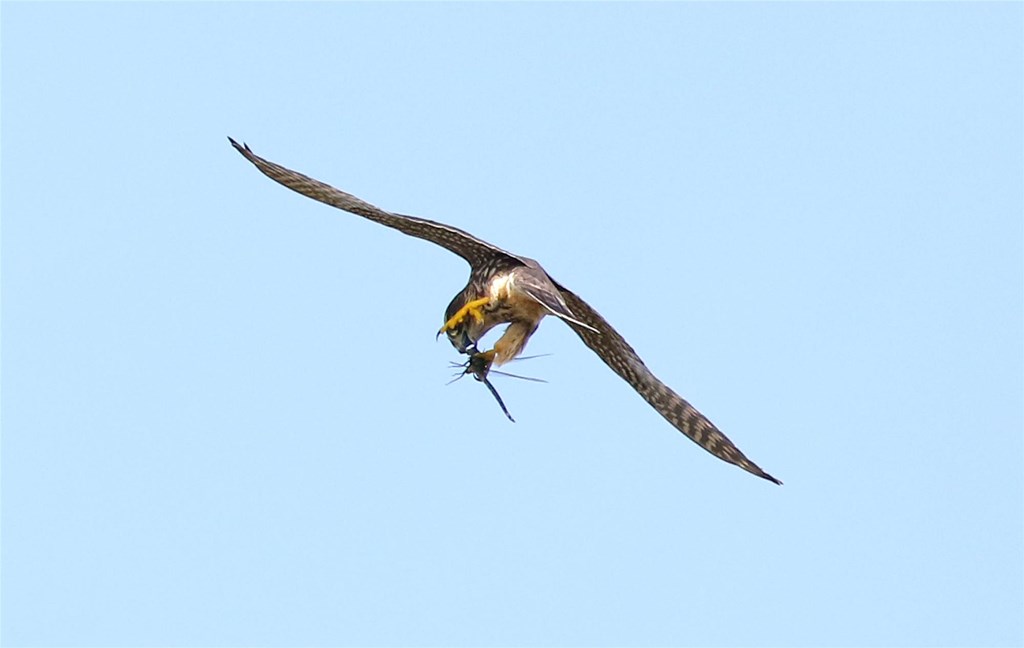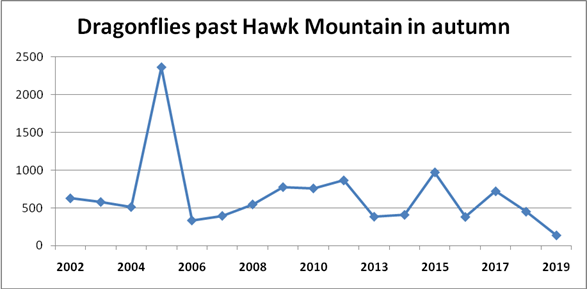Six-legged Sky Jewels
Posted on December 02, 2019 in Science

By Zoey Greenberg
What if we told you there was a creature that, as a newborn, prowled ponds and streams using part of its face as a projectile sword to stab and eat everything in sight? What if you knew that the same newborn grows into an adult that hunts the skies with multi-directional compound eyes, eats hundreds of mosquitoes per day, and can migrate up to 11,000 miles. Would you believe us? Dragonflies do all of this, and more. At Hawk Mountain, we count migrating dragonflies as they fly south, adding knowledge about when, where, how, and why they migrate. Slowly but surely, answers are surfacing.
Ask any novice birder and they will tell you that hawk watching is a test of patience and eyeball mechanics. Throw dragonflies into the mix, and you’ve got yourself an eyeball bootcamp. Dragonflies are famous for their speed and agility, and with 316 species in North America, identifying and counting is quite the test.
Green Darners are a widespread species, being the state insect of Washington as well Eastern North America’s most noticeable dragonfly migrant. Their Latin name, Anax junius, means “Lord of June, “ and aptly reflects their noble appearance. These blue, green, and purple predators undertake impressive journeys that would seem impossible for an insect with a lifespan of only one year, most of which is spent underwater. Researchers theorize that it takes multiple generations of darners to complete one full migration. Adults likely deposit eggs during migration, which then hatch into nymphs, take wing, and subsequently fulfill an additional leg of the journey. Recently, animal tracking devices have become small enough that researchers can deploy them on dragonflies. This will yield new information on where these insects are traveling, and when they stop. For the time being, however, we rely on visual observations.
Dragonflies are often seen traveling individually, although on several historic days large swarms have been seen moving south. These congregations are likely a result of climatic and geographical funneling effects that similarly direct the when, where, and how of bird migration. Hawk Mountain Sanctuary for example, is located on a ridge top because this serves as a “leading line” for migratory birds by providing free rides on updrafts and thermals that orient them towards their destination to the south. On long, energetically taxing journeys, such energy saving opportunities are hot commodities and evidence shows that dragonflies may be using the same tricks of the trade.
Places like Cape May, New Jersey and Chicago, Illinois also serve as leading lines for migrants, based on their proximity to large bodies of water that naturally, migrants hope to avoid. On September 11, 1992 Cape May experienced a major cold front followed by northwest winds. One hour later, a dragonfly swarm pushed through town. This surge in dragonfly numbers was also accompanied by an unusual increase in the number of migrating Sharp-shinned Hawks and American Kestrels, two raptor species that utilize optimal winds to make headway during migration. Experts agree that the correlations between dragonfly and bird movements are not coincidental.
Robert W. Russell and his coauthors were some of the first researchers to investigate the ecological incentives for dragonfly migration in 1998. They reviewed reports of swarms and unveiled some interesting findings in the process: first, movements occurred during the same time as bird migration, between late July and mid-October; second, most of the swarms were observed moving south in coastal locations and lakeshores which serve as leading lines; third, there was a link between the passage of large-scale cold fronts, northwest winds, and the movement of dragonfly swarms. Green Darners were the primary species in each of these events.

The paper then discussed the ecological implications of these patterns, or the why behind the movements. The authors hypothesized that the timing, species composition, and behavior of swarms is akin to long-distance migrants engaged in refueling stopovers. This behavior is strikingly parallel to that of migratory birds, which often use Cape May as a stopover sight for refueling and reorienting before crossing the Delaware Bay.
Dragonfly captures in Cape May provided further insight into the business of these swarms. Green Darners sampled during Autumn were found to have substantial amounts of fat on their bodies compared to non-migratory dragonflies of similar body mass, suggesting they (like birds) intentionally “bulk up” prior to migration. Furthermore, migrating dragonflies were witnessed changing direction upon encountering bodies of water, flying along the beach rather than crossing. This type of adjustment is a trademark of migratory behavior. Interestingly, swarms have also been seen reorienting as a group. Through such flocking behavior, they may be able to better assess risky conditions. In other words, if your neighbor gets swept out to sea, you’ll know not to follow, translating to safety, or knowledge, in numbers.

Another parallel between migratory dragonflies and birds is that they eat each other, and you can probably guess who’s eating whom. Two of North America’s smallest raptors, the American Kestrel and the Merlin, feed on insects. Many seasoned hawkwatchers have had the pleasure (or the misfortune, depending on your constitution) of watching a Merlin dismember a dragonfly on the wing, consuming the body in all of several seconds. The relative importance of this fuel source for falcons is speculative for now, but through increased documentation and participation by citizen scientists, the intersection of these sky predators will become better understood.

Dragonfly species identified at Hawk Mountain include Common Green Darners, Black Saddlebags, Variegated Meadowhawks, Spot-winged Gliders, and 12-spotted Skimmers, with darners being the most common. See graph. The numbers we collect are submitted to the Migratory Dragonfly Partnership, a collaborative project aimed at answering key questions about these dragonfly journeys. The Partnership invites the help of people everywhere to contribute. If you have a pond in your backyard, you can help. If you have ever observed a swarm of dragonflies, you can help. If you have no idea what a dragonfly looks like, you can still help. Their website offers an informational blog on all things dragonfly, as well as user friendly identification guides to help familiarize you with these six-legged sky jewels. A pair of close-focusing binoculars and willingness to notice the little things in life will prepare you for endless reward as you join the growing number of dragonfly watchers. The next time you visit Hawk Mountain, bring your newfound love of dragonflies and join us as we wish them well on their southbound journeys to who knows where!
https://www.youtube.com/watch?v=EHo_9wnnUTE
Watch this short video to see a hungry dragonfly nymph’s “spork-shaped lip” in action!
http://news.bbc.co.uk/earth/hi/earth_news/newsid_8149000/8149714.stm
Read this short article about Globe Skimmers, a dragonfly with the longest migration of any insect!
Sources
Berger, Cynthia (2004). Dragonflies. Mechanicsburg, Pennsylvania: Stackpole Books.
Robert W. Russell, Michael L. May, Kenneth L. Soltesz, and John W. Fitzpatrick "Massive Swarm Migrations of Dragonflies (Odonata) in Eastern North America," The American Midland Naturalist140(2), 325-342, (1 October 1998). https://doi.org/10.1674/0003-0031(1998)1402.0.CO;2